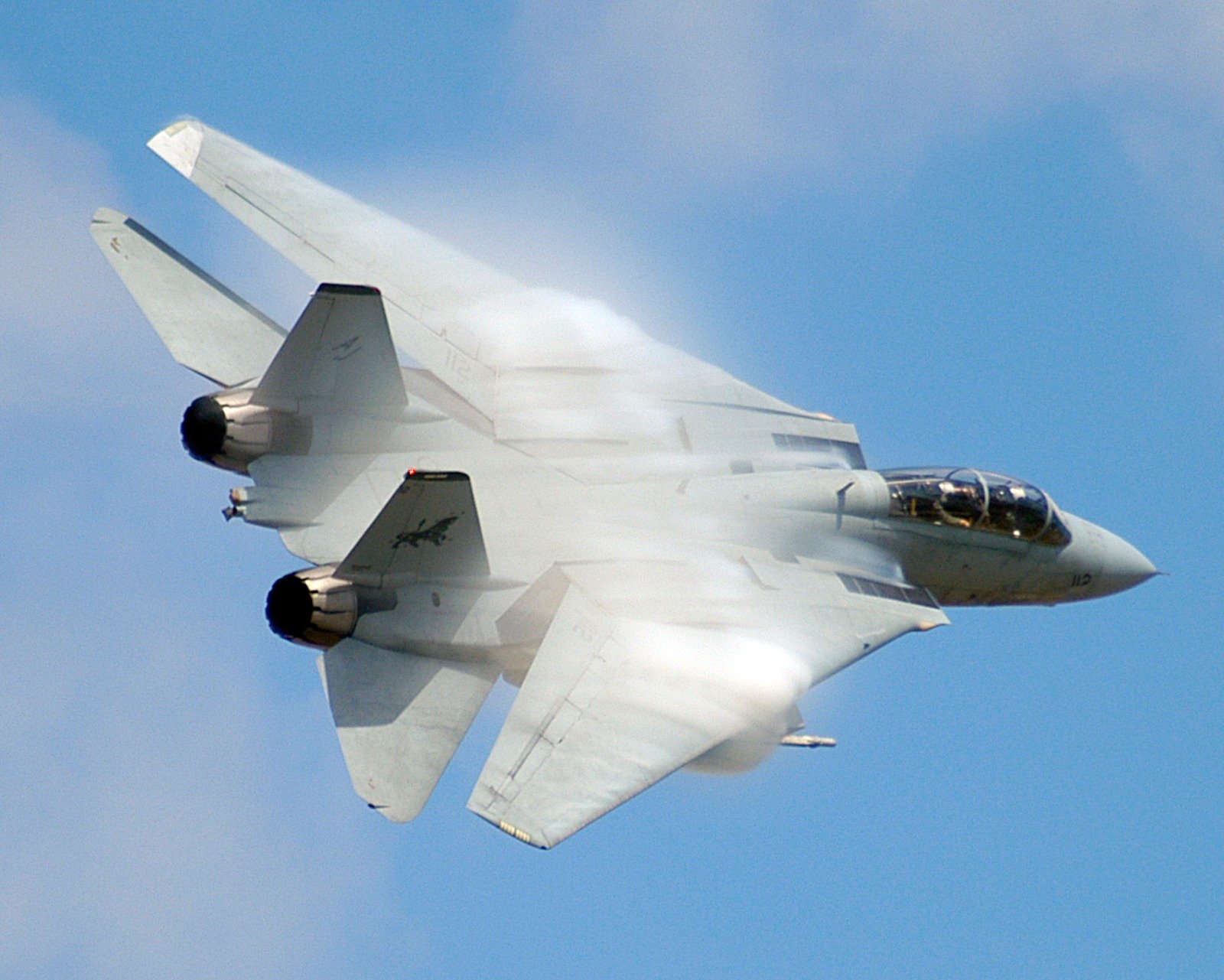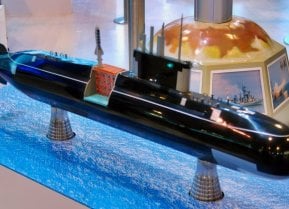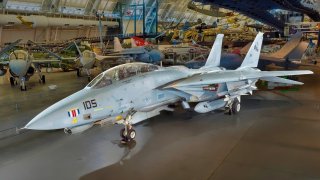Super Tomcat 21: The 'New' F-14 Fighter That Could Have Been a Game Changer
While the F-14D took on the title “Super Tomcat,” this effort to modernize the F-14 began under the moniker “ST21,” which, appropriately enough, stood for “Super Tomcat for the 21st Century,” and make no mistake — that’s precisely what it could have been.
Not long ago, we explored the reasons the legendary F-14 Tomcat found itself sent out to pasture decades before its fighter classmates from the 1970s, but there’s more to the tale of Grumman’s incredible fighter and its efforts to find a place in a post-Cold War fleet. In the early 1990’s, Grumman proposed a new iteration of the famed Top Gun fighter that was not only modern enough to still be in service today, it would have marked a vast improvement in performance and capability over even Maverick’s highly capable F-14D.
While the F-14D took on the title “Super Tomcat,” this effort to modernize the F-14 began under the moniker “ST21,” which, appropriately enough, stood for “Super Tomcat for the 21st Century,” and make no mistake — that’s exactly what it could have been.
The Navy needed a fighter with attack capabilities
In 1988, a joint team from McDonnell Douglas and General Dynamics was awarded a development contract for what was to become the A-12 Avenger II, not to be confused with Lockheed’s proposed A-12 of the 1960s, which sought to arm an SR-71 sibling jet with air-to-air weapon systems. Once completed, the Navy’s A-12 would have been a flying wing-design reminiscent of Northrop Grumman’s B-2 Spirit or forthcoming B-21 Raider, though much smaller and more triangular; earning it the nickname “Flying Dorito.”
Once completed, the A-12 would have actually been the world’s first true stealth fighter, thanks to the inclusion of onboard radar and the ability to leverage AIM-120 AMRAAM air-to-air missiles — but by 1991, the Flying Dorito was shot down by its own massive budget overruns and technical delays. You can read more about that in our full feature on the A-12 program here, but suffice to say, its cancelation left the Navy with a strike capability gap it needed to fill, especially with the A-6 Intruder’s retirement looming on the horizon.
The Tomcat had been designed from the very onset with air-to-air combat as a primary focus, with an emphasis placed on covering a great deal of ground very quickly while carrying a heavy payload of advanced AIM-54 Phoenix missiles to intercept approaching Soviet bombers. Grumman, recognizing the Navy’s need for an aircraft capable of filling the attack role, proposed a fairly inexpensive facelift for the Navy’s Tomcat fleet dubbed the F-14 Quick Strike. The Quick Strike upgrade would incorporate an infrared navigation and targeting pod similar to the LANTIRN system that found its way into the F-15E and F-16 along with upgrades to the aircraft’s powerful onboard radar for ground-attack modes. The addition of more hardpoints for standoff munitions rounded out the proposal as an economic-seeming solution.
An F-14 for the 21st Century
Of course, as we’ve discussed at length in the past, economic was never really the Tomcat’s specialty, and the Navy wasn’t particularly interested in expanding the role of its expensive and sometimes problematic F-14 fleets as they stood. To make matters worse for Grumman, McDonnell Douglas was rumored to be hard at work on development of a practically clean-sheet fighter modeled after the Navy’s other carrier-fighter, the F/A-18 Hornet.
McDonnell Douglas’ plan was to present the Navy with a new, more advanced fighter that could fill a broad swath of roles for the Navy, but delivered in a package that looked and sounded like a continuation of the successful Hornet lineage. Not only would that make the aircraft sound proven and reliable, it would be perceived as less expensive than funding development on a new fighter.

Grumman opted to offer an even more heavily upgraded iteration of the F-14 that could come as new aircraft or through remanufacture of existing platforms. The resulting ST21 (Super Tomcat for the 21st Century) and subsequent AST21(Attack Super Tomcat for the 21st Century) were designs that could have catapulted the Tomcat straight into the coming millennium it drew its name from.
Cramming a new fighter under the Tomcat’s hood
Despite the incredible capabilities offered by the most modern F-14Ds of the day, the Tomcat’s design was already more than twenty years old by the time discussion about the Super Tomcat 21 began. Often, when discussing fighter programs that are trying to stay relevant amid rapid technological progress, a dated design is something engineers are trying to compensate for, but in many ways, the Tomcat’s dated layout created a glutton of opportunity when it came to introducing new technologies to the aircraft.
Leveraging lessons learned from more than a decade and a half of service, the Super Tomcat 21 eliminated the “glove vanes” that were located just outside of each wingroot. These glove vanes were designed to create lift ahead of the aircraft’s center of gravity at supersonic speeds above Mach 1.4, pressing the nose of the aircraft up and unloading the tail planes to allow for greater high-speed maneuverability. However, the systems that controlled these planes were a maintenance nightmare, and they were eventually welded shut on most aircraft.
In place of those problematic glove vanes, the ST21 and AST21 incorporated enlarged aerodynamic gloves that offered massive benefits in terms supersonic handling and dogfighting performance while simultaneously providing room for an additional 2,200 pounds of fuel storage in each wing, granting the aircraft even greater range.
When the F-14 first took to the skies with its incredible AIM-54A Phoenix missile, the fighter had to include rail fairings to house the missile’s oil cooling system, but by the ’90s, the Navy had upgraded to AIM-54B and C iterations of the missile, neither of which required the F-14 to manage oil cooling duties. In place of these systems, the Super Tomcat 21 would house navigation and attack FLIR (Forward Looking Infrared Sensors) in these rail fairings.

Data from those systems would be fed into an entirely glass cockpit with dramatically improved avionics, a wide-angle Heads Up Display (HUD) that could project imagery from the navigational FLIR pod, upgraded APG-71 radar, and entirely new mission computers, making the Tomcat into a dated-looking fighter with the most advanced avionics available at the time.
The AST21 was largely a continuation of the ST21 design, with additional bomb-carrying pylons, a modified radar system with a Forward Air Controller (FAC) mode, an Integrated Defensive Avionics Package (IDAP), and nuclear weapons carrying capabilities.
More power, more speed, and more range
Both Super Tomcat 21 iterations saw the use of upgraded GE-F110-129 turbofan engines, in keeping with the Navy’s ongoing efforts (at the time) to replace the troubled Pratt & Whitney TF30 in their Tomcat fleets. The use of these engines in conjunction with the increased fuel capacity and improved wing aerodynamics resulted in what could have been an astonishingly capable fighter that may have been further bolstered by the inclusion of thrust vectoring nozzles taking their cues from the aircraft’s new flight computer.
The GE-F110-129 was not only a massive improvement over the TF30 still filling the fuselages of some Tomcats into the early 2000s, it was also an improvement over the F110’s the Navy’s best Tomcats employed. With approximately 30,000 pounds of thrust available from each engine under afterburner and a more efficient design, the new Tomcat would have been able to fly further than ever before at higher sustained speeds. In fact, the Super Tomcat 21 would have been able to super-cruise, or fly at supersonic speeds without the use of its afterburner, at a sustained jaw-dropping Mach 1.3.
Thrust vectoring nozzles, if the Navy had opted to include them, would have taken the new fighter’s maneuverability to a positively mind-boggling level when leveraged in conjunction with its automated sweep-wing design. According to some sources, the AST21 would have already been able to sustain 77 degrees of sustained AoA (angle of attack) thanks to the aircraft’s planned aerodynamic improvements, and thrust vector control would have pushed that even further.
With wing position controlled by an on-board computer for maximum benefit, the massive (in comparison) F-14 could already turn tighter than its tiny Air Force sibling, the F-16 Fighting Falcon, under the right circumstances. The addition of thrust-vectoring would not only have improved upon that already-impressive Angle of Attack figure, it likely would have made the Super Tomcat 21 the most acrobatic and maneuverable fighter not just of its era, but likely for decades yet to come.
Thrust vector control effectively aims the outflow of the engine’s thrust independent of the aircraft itself. This can allow the aircraft to literally continue to push forward in the sky while pointing its nose (and weapons) down at an opponent, as well as allowing for rapid maneuvering that seems to defy the laws of physics when shown on video.
Thrust vector control has long been an important element in Russian fighter design based on their emphasis on within-visual-range fights (dogfights), but within America stables, it can only be found on the ranking king of the skies, F-22 Raptor.
But Grumman wasn’t done yet. If the Navy didn’t think the ST21 or the AST21 designs were capable enough, they had one more ace up their sleeve.


